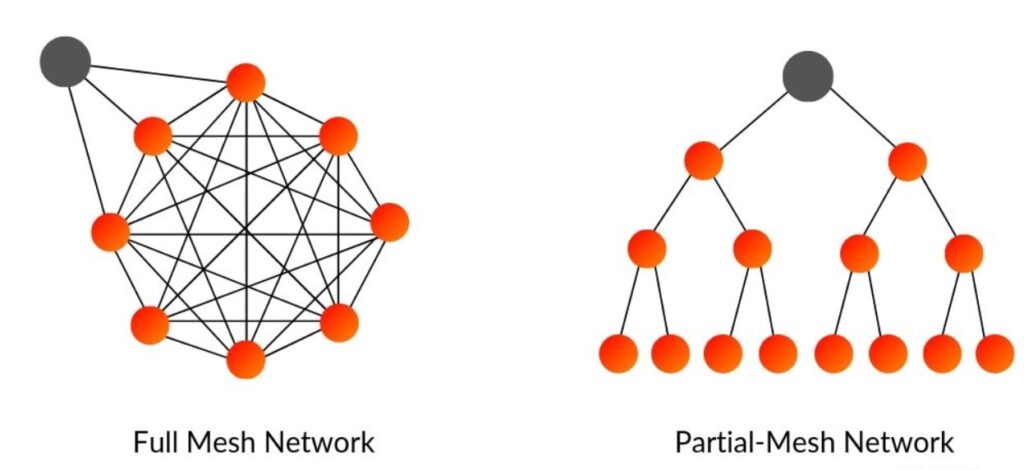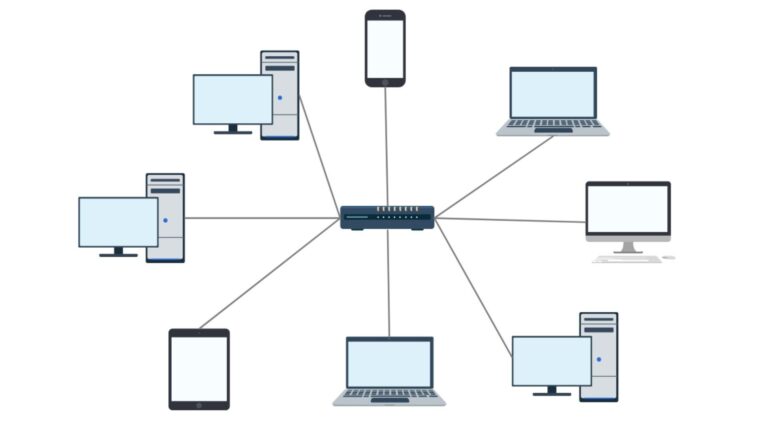Mesh Topology: The Complexities of Interconnected Networks
Mesh Topology is a fundamental networking architecture that plays a critical role in the complex web of interconnected networks, enabling modern communication systems to function. Understanding the importance of this topology requires unraveling the intricacies of its design and the role it plays in orchestrating the symphony of data and information that flows through our technological world.
Its ability to seamlessly connect devices and networks makes it a cornerstone of the ever-evolving landscape of networking architecture, ensuring safe, efficient, and reliable data transfer across multiple devices and networks. Portance is key to unraveling the complex web of interconnected networks that comprise our digital world.
Definition of Mesh Topology
Mesh Topology is a network architecture that establishes direct connections between every node present in the network, creating a complex web of interlinked nodes. In contrast to hierarchical topologies, mesh topology is highly resilient and redundant as it offers multiple pathways for data transmission. This redundancy ensures that if a link or node fails, data can still reach its intended destination through an alternative path. This makes mesh topology ideal for applications that require high reliability and availability.
Importance in Networking Architecture
Mesh Topology is a networking architecture that goes beyond simple connectivity. It serves as a backbone for robust networking structures, offering redundancy, scalability, and flexibility that are vital for modern networking paradigms. Mesh Topology ensures seamless communication even in challenging environments, making it an indispensable networking solution for businesses and organizations.
Ring Topology: Understanding the Circular Network Configuration
Understanding Mesh Topology
Overview of Mesh Network Structure
A mesh network is a type of network architecture where the nodes are interconnected in a mesh-like structure. In other words, each node in the network has direct links to other nodes, enabling efficient data transmission by allowing packets to travel through multiple pathways. This interconnectivity also enhances the reliability and fault tolerance of the network.
Core Components of Mesh Topology
- Nodes: These are the fundamental building blocks of a mesh network, representing devices or endpoints within the system. Each node acts as both a transmitter and receiver of data, contributing to the network’s interconnectedness.
- Links: Links are the physical or logical connections between nodes in a mesh network. These pathways enable the transmission of data packets from one node to another, forming the backbone of communication within the network.
- Routing Devices: Routing devices, equipped with intelligent routing algorithms, play a crucial role in directing data traffic within the mesh network. These devices determine the optimal pathways for data transmission, ensuring efficient and reliable communication.
Advantages of Mesh Topology

Redundancy and Reliability
Mesh topology is a type of network architecture that provides exceptional redundancy by offering multiple pathways for data transmission between nodes. This means that in case of any link failures or network congestion, alternative routes can be utilized to ensure uninterrupted communication and enhance the overall reliability and fault tolerance of the network. The mesh topology’s inherent redundancy is a key advantage that allows for seamless communication among network nodes, making it an ideal choice for mission-critical applications in industries such as finance, healthcare, and transportation.
Scalability and Flexibility
Mesh topology is a network architecture that offers various advantages over other topologies. One of the key advantages of mesh topology is its scalability and flexibility. This means that the network can easily accommodate the addition of new nodes or the expansion of existing ones, making it suitable for growing networks and evolving infrastructure requirements.
In a mesh network, each node is connected to every other node in the network, which results in a highly redundant and robust network. This redundancy ensures that even if one of the nodes fails or goes offline, the network continues to function without any disruption. Additionally, the flexibility of mesh topology allows for multiple paths between nodes, which further enhances the reliability and performance of the network.
Mesh topology is particularly useful for large-scale networks that require high levels of reliability and performance. For example, it is commonly used in military, aviation, and transportation industries where network downtime can have severe consequences. The ability to easily expand and reconfigure mesh networks also makes them a popular choice for growing businesses and organizations with changing infrastructure requirements.
Disadvantages of Mesh Topology
Cost Considerations
Mesh topology can be an effective way to create a network where every node is connected, providing high redundancy and fault tolerance. However, it’s important to note that implementing this type of topology can lead to significant infrastructure expenses, particularly in fully interconnected mesh networks. These expenses include not only the cost of the physical hardware but also the installation and maintenance costs, which can be higher due to the complexity of the network design. Nonetheless, the benefits of a mesh topology make it a viable option for many organizations, particularly those that require high levels of reliability and availability in their networks.
Complexity in Design
Setting up a mesh network can be a challenging task that demands careful planning and management. Due to the presence of a significant number of nodes and links, configuring the network can become a complex process. Additionally, managing the interconnectedness of the network can lead to increased management overhead, which requires a high level of attention and expertise.
Types of Mesh Topology

Full Mesh Topology
In a full mesh topology, each device is interconnected with every other device within the network. This type of configuration provides the highest level of redundancy and reliability, enabling seamless communication even in the event of link failures. Essentially, a full mesh topology ensures that there are multiple paths for data to travel, guaranteeing that messages will reach their intended recipients.
Partial Mesh Topology
In partial mesh topology, the nodes are selectively connected. This type of topology strikes a balance between redundancy and cost efficiency. Unlike in a full mesh topology, not every node is directly connected to all others in a partial mesh topology. This helps in keeping the infrastructure costs low while still maintaining a degree of redundancy in the network.
Mesh Topology Protocol
Dynamic Routing Protocols
Dynamic routing protocols like OSPF (Open Shortest Path First) and EIGRP (Enhanced Interior Gateway Routing Protocol) are designed to facilitate automatic route calculation based on network conditions. These protocols continuously monitor the network and dynamically adjust routing tables to ensure efficient and reliable data transmission within the mesh network. This helps to optimize network performance and reduce network congestion, thus improving the overall network efficiency.
Static Routing Protocols
In computer networking, static routing protocols require the manual setup of routing tables, which enables network administrators to determine particular routes for data transmission. This approach offers greater control over network traffic, but it may demand more intricate configuration and management.
Data Transmission in Mesh Topology
Packet Routing Process
In a mesh network, the process of transmitting data packets involves finding the best pathways for efficient data transfer. Routing devices utilize algorithms, which take into account various factors such as latency, bandwidth availability, and network congestion to determine the most optimized routes for data transfer. This ensures that data is transmitted most quickly and reliably as possible.
Load Balancing Mechanisms
Load balancing is a crucial aspect of network traffic management. It involves the distribution of network traffic across available pathways, thereby optimizing resource utilization and minimizing congestion. By balancing the load across multiple servers, load-balancing mechanisms ensure efficient data transmission and prevent bottlenecks in the network. These mechanisms are essential for maintaining a healthy network and ensuring smooth and uninterrupted data flow.
Data Integrity and Security Measures
Encryption Techniques
To maintain the privacy and security of data while transmitting it over the network, advanced encryption techniques are utilized. These techniques convert data packets into a coded form that can only be deciphered by authorized parties, thereby eliminating the possibility of unauthorized access or eavesdropping. This ensures the confidentiality and integrity of transmitted data, providing a reliable and secure means of data transfer.
Authentication Protocols
Authentication protocols are an integral part of network security. Their primary function is to verify the identity of users or devices attempting to access the network. Through this process, authentication protocols ensure that only authorized entities are allowed entry, which helps prevent unauthorized access and protects against network intrusions. Overall, authentication protocols play a crucial role in maintaining the security and integrity of modern computer networks.
Examples of Mesh Topology
Wireless Mesh Networks
Wireless mesh networks are a type of network that consists of multiple interconnected Wi-Fi access points. These access points work together to provide seamless connectivity and coverage over a wide area, making them a popular choice for urban environments, public spaces, and outdoor settings where traditional wired infrastructure may not be feasible. Thanks to their ability to expand and adapt to changing needs, wireless mesh networks are becoming increasingly popular in various applications and industries.
Internet Backbone Networks
The Internet backbone networks are designed with a mesh topology to connect various network nodes globally. These networks play a crucial role in enabling high-speed data transmission between internet service providers (ISPs), content delivery networks (CDNs), and other core infrastructure components, thus ensuring seamless and reliable internet connectivity worldwide.
Comparison with Other Topologies
Mesh vs. Star Topology
When it comes to network topologies, star topology and mesh topology are two popular options. While the star topology relies on a central hub for communication, mesh topology takes a different approach. In a mesh network, each node is connected to multiple other nodes, creating a web-like structure of interconnected devices. This means that data can be transmitted through multiple pathways, rather than relying on a single point of communication.
One of the key advantages of mesh topology is its redundancy and fault tolerance. Since each node has multiple pathways for data transmission, there is less risk of a single point of failure bringing down the entire network. If one node fails or becomes unavailable, data can simply be routed through a different pathway to reach its destination. This ensures continuous connectivity and helps to minimize downtime in the event of a failure or outage.
Overall, mesh topology can be a great option for larger networks where redundancy and fault tolerance are a priority. While it may require more initial setup and configuration than a star topology, its benefits in terms of reliability and resilience can make it well worth the investment.
Star Topology: Illuminating Network Connectivity
Mesh vs. Bus Topology
Mesh topology and bus topology are two different types of network topologies used in computer networking. While bus topology uses a single communication line, known as a bus, that is shared by all nodes, mesh topology offers a different approach by segmenting the network into interconnected pathways. In a mesh topology, each node is connected to every other node in the network through multiple paths, allowing data to be transmitted more efficiently and reliably.
This also means that traffic can be managed more effectively, as there are multiple routes for data to take in the event of a failure or congestion on one path. Additionally, mesh topology offers greater scalability, as nodes can be added or removed without affecting the rest of the network. Overall, mesh topology is a more robust and flexible option for network design, particularly in larger and more complex networks where reliability and performance are critical.
Implementing Mesh Topology
Network Architecture Planning
When it comes to implementing mesh topology in a network, the first step is to plan the network architecture. This involves various factors such as determining node placement, connectivity mapping, and infrastructure design. During this phase, it is important to take into account factors like network size, traffic patterns, and resource requirements. Proper planning can help ensure a robust and efficient network that meets the needs of the users.
Configuration and Setup
After finalizing the network architecture plan, the subsequent step is the configuration and setup phase. This phase primarily involves the assignment of network addresses, configuring routing tables, and managing network devices. Network administrators must ensure that routing devices are correctly configured to enable smooth and efficient data transmission throughout the mesh network. Proper configuration of routing devices enables the network to operate seamlessly, ensuring smooth data communication and timely delivery of information.
Maintenance and Troubleshooting
Proactive Maintenance Strategies
To maintain the reliability and performance of a mesh network, it is crucial to implement proactive maintenance strategies. Conducting regular network health checks, keeping the firmware updated, and applying patches can help prevent potential issues and ensure the smooth operation of the network. These maintenance tasks are essential to keep the network functioning optimally and prevent any downtime or disruptions that may impact its performance.
Troubleshooting Common Issues
If you’re using a mesh network, you might come across problems like connectivity issues, node failures, or performance bottlenecks. These issues can cause lengthy downtimes and affect the reliability of your network. To avoid such problems, it’s necessary to troubleshoot and fix them immediately. By doing so, you can ensure that your network remains stable and reliable at all times.
Future Trends and Innovations
Software-Defined Mesh Networking
Mesh topology is evolving rapidly, and the future of this network architecture lies in software-defined networking (SDN). SDN is a cutting-edge technology that provides programmable network configurations and dynamic adaptation to changing conditions, making it a game-changer for mesh networks. With SDN, administrators can manage and optimize mesh networks more efficiently, leading to improved performance and scalability. This technology is paving the way for a more streamlined and effective approach to network management, and it is poised to revolutionize the way we think about mesh topology in the years to come.
Mesh Networks in IoT
The Mesh topology is becoming increasingly important in the Internet of Things (IoT) ecosystem and is vital for enabling device interconnectivity and data exchange. In various IoT applications, such as smart home automation, industrial monitoring, and environmental sensing, mesh networks play a crucial role in enabling seamless communication between devices. This type of network topology ensures that information is transmitted effectively and efficiently, making it an essential component in the development of IoT solutions.
Conclusion
Mesh topology is an important part of modern networking. It helps connect multiple networks and provides redundancy, scalability, and flexibility. This is important for communication systems to work well. Without mesh topology, we would not have the efficient communication we have today.




